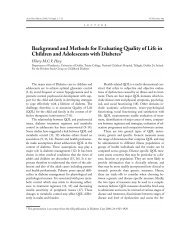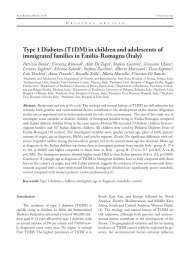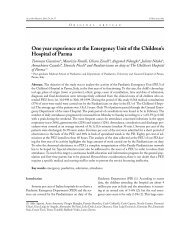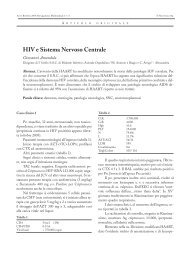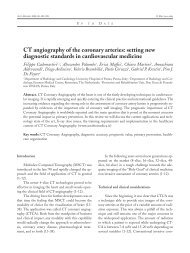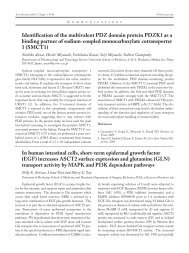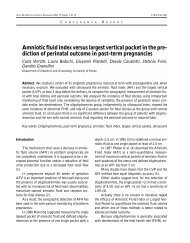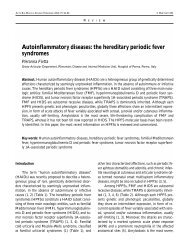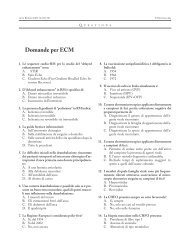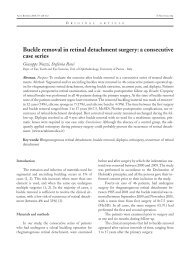Infliximab treatment in Psoriatic Arthritis: our experience - Acta Bio ...
Infliximab treatment in Psoriatic Arthritis: our experience - Acta Bio ...
Infliximab treatment in Psoriatic Arthritis: our experience - Acta Bio ...
Create successful ePaper yourself
Turn your PDF publications into a flip-book with our unique Google optimized e-Paper software.
ACTA BIOMED 2006; 77; 95-102 © Mattioli 1885O R I G I N A L A R T I C L E<strong>Infliximab</strong> <strong>treatment</strong> <strong>in</strong> <strong>Psoriatic</strong> <strong>Arthritis</strong>: <strong>our</strong> <strong>experience</strong>Walter Troise Rioda, Giuditta AdorniDepartment of Internal Medic<strong>in</strong>e and <strong>Bio</strong>medical Sciences - Rheumatology Section University of Parma, Parma, ItalyAbstract. The aim of this work was to give cl<strong>in</strong>ical practice recommendations on the use of tum<strong>our</strong> necrosisfactor block<strong>in</strong>g agents <strong>in</strong> psoriatic arthritis, underl<strong>in</strong><strong>in</strong>g the pathogenetic mechanism of this condition andits articular and dermatologic manifestations. We retrace the stages lead<strong>in</strong>g to the therapeutic <strong>in</strong>dications ofbiological agents that are presently used <strong>in</strong> the <strong>treatment</strong> of psoriatic arthritis: Entanercept, Adalimumab, <strong>Infliximab</strong>.We also report <strong>our</strong> personal <strong>experience</strong> describ<strong>in</strong>g an emblematic case of a patient with psoriaticarthritis <strong>in</strong> which a decisive regression of jo<strong>in</strong>t/sk<strong>in</strong> <strong>in</strong>volvement was obta<strong>in</strong>ed with <strong>Infliximab</strong> <strong>treatment</strong>.(www.actabiomedica.it)Key words: <strong>Psoriatic</strong> arthritis, cutaneous psoriasis, TNF-α,TNF-α block<strong>in</strong>g agents, <strong>Infliximab</strong><strong>Psoriatic</strong> arthritis is a chronic, debilitat<strong>in</strong>g conditionthat is characterized by the presence of psoriasis,<strong>in</strong>flammation of the jo<strong>in</strong>ts and vertebral column, andenthesitis. It is also def<strong>in</strong>ed as a seronegative spondylopathywhich is usually progressive and debilitat<strong>in</strong>g(1, 2). Around 40% of the patients present progressiveand destructive arthritis (3). Various studies have demonstratedthat the frequency of psoriatic arthritis variesfrom 5 to 42% <strong>in</strong> patients with psoriasis (4-6).This condition usually appears <strong>in</strong> subjects around theages of 40 and 50. Patients usually show stiffness,swell<strong>in</strong>g and pa<strong>in</strong> of the jo<strong>in</strong>ts and surround<strong>in</strong>g tissues,especially <strong>in</strong> the f<strong>in</strong>gers and toes. The majority ofthe patients have poliarthitis, others have asymmetricaloligoarthritis, but these forms may vary dur<strong>in</strong>g thec<strong>our</strong>se of the disease (7). The sp<strong>in</strong>e and sacroiliacjo<strong>in</strong>ts are affected <strong>in</strong> 20-40% of the cases while theisolated form is present <strong>in</strong> approximately 3% of patients(1, 3, 8). Enthesitis, periostial reaction, anddactylitis are associated with psoriatic arthritis. Extraarticularand extra-dermatologic manifestations <strong>in</strong>cludeiritis, conjunctivitis, and mucosal membrane lesions.90% of the patients also show alterations of thenails (pitt<strong>in</strong>g of f<strong>in</strong>gers and toes) (1, 2, 7). Both psoriasisand psoriatic arthritis significantly reduce thequality of life and the presence of arthritis <strong>in</strong> a psoriaticpatient drastically contributes to the decl<strong>in</strong>e <strong>in</strong> thequality of life (9, 10).Recent studies have shown the progressive natureof the condition <strong>in</strong> the majority of patients that werestudied <strong>in</strong> a two-year period (11, 12).This condition is associated with an <strong>in</strong>creasedmortality rate that is due to cardiovascular disease (13).Family history is common <strong>in</strong> psoriatic arthritisand there is no sex difference <strong>in</strong> <strong>in</strong>cidence. Populationstudies have identified different genetic HLA associationswith psoriatic arthritis, such as HLA-B7 andHLA-B27 (14-18).The dermatologic and articular manifestationsare characterized by chronic <strong>in</strong>flammation. Tlymphocytes seem to play a key role <strong>in</strong> guid<strong>in</strong>g thisprocess <strong>in</strong> both the sk<strong>in</strong> and jo<strong>in</strong>ts; an altered responseof kerat<strong>in</strong>ocytes to the production of INF-γ by Tlymphocytes and the beneficial effect of therapies aimedat T lymphocytes are based on the clonal characteristicsof sk<strong>in</strong> and synovial <strong>in</strong>filtrations of Tlymphocytes that are antigen-specific (19-30). The synoviais <strong>in</strong>filtrated by a variety of <strong>in</strong>flammatory cells
98 W.Troise Rioda, G. AdorniA second study (IMPACT2) was later conducted(67). In this study 200 patients randomly receivedeither <strong>in</strong>fliximab or the placebo for 24 weeks. TheACR20, 50 and 70 at the 24 th week were reached by54%, 41%, 27% of the patients that were treated with<strong>in</strong>fliximab compared to 11%, 4%, 2% of those receiv<strong>in</strong>gthe placebo. PASI75 was reached by 60% of thegroup treated with <strong>in</strong>fliximab and by 1% of the groupreceiv<strong>in</strong>g the placebo.The radiographic progression of the disease wasvalued through two studies (68, 69). The first study utilizedthe Sharp method that was modified for psoriaticarthritis. At the 24 th week this method showed a variationof -0.7±2.53 <strong>in</strong> patients treated with <strong>in</strong>fliximabcompared to a variation of +0.82±2.62 <strong>in</strong> patients receiv<strong>in</strong>gthe placebo. At the 50 th week, the study showed ahalt <strong>in</strong> the radiographic progression <strong>in</strong> both patientsthat had received <strong>in</strong>fliximab dur<strong>in</strong>g all 50 weeks and <strong>in</strong>those who had been treated from the 16 th to the 50 thweek. The second study analyzed the radiographic progressionof the disease <strong>in</strong> 72 patients. Patients were <strong>in</strong>itiallyrandomized <strong>in</strong>to a double-bl<strong>in</strong>ded study and received<strong>in</strong>fliximab or the placebo for 14 weeks, subsequentlyall patients bl<strong>in</strong>dly received <strong>in</strong>fliximab up untilthe 50 th week. It emerged that, at the 50 th week, patients<strong>in</strong> both the placebo/<strong>in</strong>fliximab group and patients <strong>in</strong>the <strong>in</strong>fliximab/<strong>in</strong>fliximab group did not show a worsen<strong>in</strong>g<strong>in</strong> the modified vdH-S total score.Treatment with <strong>Infliximab</strong> is usually well tolerated.The most common side effects of this drug <strong>in</strong>cludeheadaches, upper respiratory tract <strong>in</strong>fections, and adm<strong>in</strong>istrationreactions (48). A prolonged use has been associatedwith the production of anti-<strong>in</strong>fliximab antibodies,which is the reason for which methotrxate is associatedto the therapy. These antibodies can reduce theefficacy of <strong>in</strong>fliximab with time, mak<strong>in</strong>g an <strong>in</strong>crease <strong>in</strong>its dose necessary (70,71). Rare cases of demyel<strong>in</strong>at<strong>in</strong>gpathologies, lupus-like conditions, and opportunistic<strong>in</strong>fections <strong>in</strong>clud<strong>in</strong>g tuberculosis have been described <strong>in</strong>patients <strong>in</strong> <strong>treatment</strong> with <strong>in</strong>fliximab (72).Our <strong>experience</strong>We treated 11 patients (7 male, 4 female), diagnosedwith psoriatic arthritis, with an <strong>in</strong>fusion of 5mg/kg of <strong>in</strong>fliximab at week 0, 2, and 6 and then every8 weeks, follow<strong>in</strong>g the classic scheme (66).In this article we discuss an emblematic case of apatient treated with <strong>in</strong>fliximab that showed improvementof his arthritis and dermatologic manifestations.The patient was a 61 year old male affected bypsoriatic arthritis s<strong>in</strong>ce 1979: the psoriasis appeared <strong>in</strong>1975 (diffuse manifestations localized on his chest,back, upper and lower limbs) then followed by the appearanceof the classic symptoms of arthritis (sausagef<strong>in</strong>gers, <strong>in</strong>volvement of distal <strong>in</strong>terphalangeal and metacarpophalangealjo<strong>in</strong>ts, nail alterations, <strong>in</strong>volvementof the left knee).Initial <strong>treatment</strong> <strong>in</strong>cluded 10 mg of methotrexategiven <strong>in</strong>tramuscularly once a week, NSAIDs, and lowdoses of steroids which obta<strong>in</strong>ed a discrete resolutionof symptoms. Inflammation <strong>in</strong>dexes were reduced(VES from 45 to 28 1h; PCR from 3,18 to 1,28 (NV
<strong>Infliximab</strong> <strong>treatment</strong> <strong>in</strong> <strong>Psoriatic</strong> <strong>Arthritis</strong>99Table 1Time VES 1 h PCR mg/dl AIMS 2 SF 36 HAQ DAS0 32 1,45 33,38 631,5 7,0 3,84week 2 13 0,42 27,25 698,5 3,0 1,68week 6 10 0,28 25,75 678,0 1,0 0,83week 14 8 0,11 22,25 686,5 1,0 0,90ConclusionsOur <strong>experience</strong>, even with a limited case number,confirms the f<strong>in</strong>d<strong>in</strong>gs <strong>in</strong> literature on the validity of<strong>treatment</strong> with <strong>Infliximab</strong> <strong>in</strong> psoriatic arthritis.We wanted to report this case which seems emblematic<strong>in</strong> demonstrat<strong>in</strong>g the beneficial effects of<strong>in</strong>jections of <strong>Infliximab</strong> on dermatological manifestations,already documented <strong>in</strong> literature (63-67).It is <strong>in</strong>terest<strong>in</strong>g to note the decisive improvementafter the first <strong>in</strong>jections of <strong>in</strong>fliximab <strong>in</strong> articular andparticularly <strong>in</strong> dermatological manifestations. Thisimprovement was ma<strong>in</strong>ta<strong>in</strong>ed after 5 months from thefirst <strong>in</strong>jection.At this po<strong>in</strong>t is crucial to understand how longthis improvement is ma<strong>in</strong>ta<strong>in</strong>ed and how long thetherapy must be cont<strong>in</strong>ued; this is the object of manydiscussions <strong>in</strong> literature (74, 75).ReferencesFigure 1. Dermatological manifestations at basel<strong>in</strong>e, after 2week, after 6 weeks, and 14 weeks from the first <strong>in</strong>jection1. Gladman DD, Shuckett R, Russell ML, Thorne JC, SchachterRK. <strong>Psoriatic</strong> arthritis (PSA) - an analysis of 220 patients.Q J Med 1987; 62 (238): 127-41.2. Gladman DD, Brockbank J. <strong>Psoriatic</strong> arthritis. Exper Op<strong>in</strong>Investig Drugs 2000; 9: 1511-22.3. Torre Alonso JC, Rodriguez Perez A, Arribas Castrillo JM,Ball<strong>in</strong>a Garcia J, Riestra Noriega JL, Lopez Larrea C. <strong>Psoriatic</strong>arthritis (PA): a cl<strong>in</strong>ical, immunological and radiologicalstudy of 180 patients. Br J Rheumatol 1991; 30 (4): 245-50.4. Gladman DD, Antoni C, Mease P, DO Clegg, Nash P. <strong>Psoriatic</strong>arthritis: epidemiology, cl<strong>in</strong>ical features, c<strong>our</strong>se, andoutcome. Ann Rheum Dis 2005; 64: 14-7.5. Cerv<strong>in</strong>i C, Leard<strong>in</strong>i G, Mathieu A, Punzi L, Scarpa R. ArtritePsoriasica: aspetti epidemiologici e cl<strong>in</strong>ici <strong>in</strong> 1.306 pazientiafferenti 37 strutture reumatologiche italiane. Reumatismo2005; 57(4): 283-90.6. Gisondi P, Girolomoni G, Sampogna F, Tabolli S, Abeni D.Prevalence of psoriatic arthritis and jo<strong>in</strong>t compla<strong>in</strong>ts <strong>in</strong> a largepopulation of italian patients hospitalised for psoriasis.Eur J Dermatol 2005; 15(4): 279-83.
100 W.Troise Rioda, G. Adorni7. Moll JM, Wright V. <strong>Psoriatic</strong> arthritis. Sem<strong>in</strong> <strong>Arthritis</strong>Rheum 1973; 3: 55-78.8. ElKayam O, Ophir J, Yaron M, Caspi D. <strong>Psoriatic</strong> <strong>Arthritis</strong>:<strong>in</strong>terrelationship between sk<strong>in</strong> and jo<strong>in</strong>t manifestationsrelated to onset, c<strong>our</strong>se and distribution. Cl<strong>in</strong> Rheumatol2000; 19: 301-5.9. Krueger G, Koo J, Lebwohl M, Menter A, Stern RS, RolstadT. The impact of psoriasis on quality of life: results ofa 1998 National Psoriasis Foundation patient-membershipsurvey. Arch Dermatol 2001; 137: 280-4.10. Husted JA, Gladman DD, Farewell VT, Cook RJ. Healthrelated quality of life of patients with psoriathic arthritis: acomparison with patients with rheumatoid arthritis. <strong>Arthritis</strong>Rheum 2001; 45: 151-8.11. Mease PJ, Kivitz AJ, Burch FX , et al. Cont<strong>in</strong>ued <strong>in</strong>hibitionof radiographic progression <strong>in</strong> patients with psoriatic arthritisfollow<strong>in</strong>g 2 years of <strong>treatment</strong> with etanercept. J Rheumatol2006; 33 (3): 1-10.12. Gladman DD, Stafford-Brady F, Chang CH, LewandoskyK, Russel ML. Longitud<strong>in</strong>al study of cl<strong>in</strong>ical and radiologicalprogression <strong>in</strong> psoriatic arthritis. J Rheumatol 1990;17: 809-12.13. Peters MJ, van der Horst-bru<strong>in</strong>sma IE, Dijkmans BA, NurmohamedMT. Cardiovascular risk profile of patients withspondylarthropathies, particularly ankylos<strong>in</strong>g spondylitisand psoriatic arthritis. Sem<strong>in</strong> <strong>Arthritis</strong> Rheum 2004; 34 (3):585-92.14. Kammer GM, Soter NA, Gibson DJ, Schur PH. <strong>Psoriatic</strong>arthritis: a cl<strong>in</strong>ical, immunologic and HLA study of 100 patients.Sem<strong>in</strong> <strong>Arthritis</strong> Rheum 1979; 9: 75-97.15. Hohler T, Marker-Hermann E. <strong>Psoriatic</strong> arthritis: cl<strong>in</strong>icalaspects, genetics, and the role of T cells. Curr Op<strong>in</strong> Rheumatol2001; 13: 273-9.16. Henseler T. The genetics of psoriasis. J Am Acad Dermatol1997; 37: S1-11.17. Swanbeck G, Inerot A, Mart<strong>in</strong>sson T, et al. Genetic counsell<strong>in</strong>g<strong>in</strong> psoriasis: empirical data on psoriasis among firstdegreerelatives of 3095 psoriatic probands. Br J Dermatol1997; 137: 939-42.18. Moll JM, Wright V. Familial occurrence of psoriatic arthritis.Ann Rheum Dis 1973; 32: 181-201.19. Fearon U, Veale DJ. Pathogenesis of psoriatic arthritis. Cl<strong>in</strong>Exp Dermatol 2001; 26: 333-7.20. Ortonne JP. Recent developments <strong>in</strong> the understand<strong>in</strong>g ofthe pathogenesis of psoriasis. Br J Dermatol 1999; 140(Suppl 54): 1-7.21. Esp<strong>in</strong>oza LR, van Sol<strong>in</strong>gen R, Cuellar ML, Angulo J. Insights<strong>in</strong>to the pathogenesis of psoriasis and psoriatic arthritis.Am J Med Sci 1998; 316: 271-6.22. Gottlieb SL, Gilleaudeau P, Johnson R, et al. Response ofpsoriasis to a lymphocyte-selective tox<strong>in</strong> (DAB389IL-2)suggests a primary immune, but not kerat<strong>in</strong>ocyte, pathogenicbasis. Nat Med 1995; 1: 442-7.23. Strange P, Cooper KD, Hansen ER, et al. T-lymphocyteclones <strong>in</strong>itiated from lesional psoriatic sk<strong>in</strong> release growthfactors that <strong>in</strong>duce kerat<strong>in</strong>ocyte proliferation. J Invest Dermatol1993; 101: 695-700.24. Pr<strong>in</strong>z JC, Gross B, Vollmer S, et al. T cell clones from psoriasissk<strong>in</strong> lesions can promote kerat<strong>in</strong>ocyte proliferation <strong>in</strong>vitro via secreted products. Eur J Immunol 1994; 24: 593-8.25. Costello P, Bresnihan B, O’Farrelly C, FitzGerald O. Predom<strong>in</strong>anceof CD81 T lymphocytes <strong>in</strong> psoriatic arthritis. JRheumatol 1999; 26: 1117-24.26. Tassiulas I, Duncan SR, Centola M, Theofilopoulos AN,Boumpas DT. Clonal characteristics of T cell <strong>in</strong>filtrates <strong>in</strong>sk<strong>in</strong> and synovium of patients with psoriatic arthritis. HumImmunol 1999; 60: 479-91.27. Costello PJ, W<strong>in</strong>chester RJ, Curran SA, et al. <strong>Psoriatic</strong>arthritis jo<strong>in</strong>t fluids are characterized by CD8 and CD4 Tcell clonal expansions appear antigen driven. J Immunol2001; 166: 2878-86.28. Mussi A, Bonifati C, Carducci M, et al. Serum TNF-alphalevels correlate with disease severity and are reduced by effectivetherapy <strong>in</strong> plaque-type psoriasis. J <strong>Bio</strong>l Regul HomeostAgents 1997; 11: 115-8.29. Ettehadi P, Greaves MW, Wallach D, Aderka D, CampRD. Elevated tum<strong>our</strong> necrosis factor-alpha (TNF-alpha)biological activity <strong>in</strong> psoriatic sk<strong>in</strong> lesions. Cl<strong>in</strong> Exp Immunol1994; 96: 146-51.30. Partsch G, Ste<strong>in</strong>er G, Leeb BF, Dunky A, Broll H, SmolenJS. Highly <strong>in</strong>creased levels of tumor necrosis factor alphaand other pro<strong>in</strong>flammatory cytok<strong>in</strong>es <strong>in</strong> psoriatic arthritissynovial fluid. J Rheumatol 1997; 24: 518-23.31. Terajima S, Higaki M, Igarashi Y, Nogita T, Kawashima M.An important role of tumor necrosis factor-alpha <strong>in</strong> the <strong>in</strong>ductionof adhesion molecules <strong>in</strong> psoriasis. Arch DermatolRes 1998; 290: 246-52.32. Riccieri V, Spadaro A, Taccari E, et al. Adhesion moleculeexpression <strong>in</strong> the synovial membrane of psoriatic artrithis.Ann Rheum Dis 2002; 61: 569-70.33. Ritchl<strong>in</strong> C, Haas-Smith SA, Hicks D, Cappuccio J, OsterlandCK, Looney RJ. Patterns of cytok<strong>in</strong>e production <strong>in</strong>psoriatic synovium. J Rheumatol 1998; 25 (8): 1544-52.34. Kupper TS. Immunologic targets <strong>in</strong> psoriasis. N Engl J Med2003; 349: 1987-90.35. Koch AE, Kunkel SL, Strieter RM. Cytok<strong>in</strong>es <strong>in</strong> rheumatoidarthritis. J Investig Med 1995; 43: 28-38.36. Fraser A, Fearon U, Bill<strong>in</strong>ghurst RC, et al. Turnover of typeII collagen and aggrecan <strong>in</strong> cartilage matrix at the onsetof <strong>in</strong>flammatory arthritis <strong>in</strong> humans: relationship to mediatorsof systemic and local <strong>in</strong>flammation. <strong>Arthritis</strong> Rheum2003; 48 (11): 3085-95.37. Teitelbaum SL. Bone resorption by osteoclasts. Science2000; 289 (5484): 1504-8.38. Ritchl<strong>in</strong> CT, Haas-Smith SA, Li P, Hicks DG, SchwarzEM. Mechanisms of TNF-alpha- and RANKL-mediatedosteoclastogenesis and bone resorption <strong>in</strong> psoriatic arthritis.J Cl<strong>in</strong> Invest 2003; 111 (6): 821-31.39. Goedkoop AY, Kraan MC, Teunissen MB, et al. Early effectsof tum<strong>our</strong> necrosis factor alpha blockade on sk<strong>in</strong> andsynovial tissue <strong>in</strong> patients with active psoriasis and psoriaticarthritis. Ann Rheum Dis 2004; 63 (7): 769-73.40. Jones G, Crotty M, Brooks P. Interventions for treat<strong>in</strong>g psoriaticarthritis. Cochrane Database Syst Rev CD000212.
<strong>Infliximab</strong> <strong>treatment</strong> <strong>in</strong> <strong>Psoriatic</strong> <strong>Arthritis</strong>10141. Roenigk HH Jr, Auerbach R, Maibach H, We<strong>in</strong>ste<strong>in</strong> G,Lebwohl M. Methotrexate <strong>in</strong> psoriasis: consensus conference.J Am Acad Dermatol 1998; 38: 478-85.42. Moreland LW. Inhibitors of tumor necrosis factor: new<strong>treatment</strong>s options for rheumatoid arthritis. Cleve Cl<strong>in</strong> JMed 1999; 66 (6): 367-74.43. Kavanaugh A, Cohen S, Cush J. The evolv<strong>in</strong>g use of TNF<strong>in</strong>hibitors <strong>in</strong> rheumatoid arthritis. J rheumatol 2004; 31:1881-4.44. Braun J, Sieper J. Role of novel biological therapies <strong>in</strong> psoriaticarthritis. <strong>Bio</strong>drugs 2003; 17: 187-99.45. Haraoui B. Differentiat<strong>in</strong>g the efficacy of the tumor necrosisfactor <strong>in</strong>hibitors. Sem<strong>in</strong>ars <strong>in</strong> arthritis and rheumatism2005; 34 (suppl 1): 7-11.46. Mease PJ, Antoni CE. <strong>Psoriatic</strong> arthritis <strong>treatment</strong>: biologicalresponse modifier. Ann Rheum Dis 2005; 64 (suppl II):ii78-ii82.47. We<strong>in</strong>berg JM. An overview of <strong>in</strong>fliximab, etanercept, efalizumab,and alefacept as biologic therapy for psoriasis. Cl<strong>in</strong>Ther 2003; 25: 2487-505.48. Nurmohamed MT, Dijkmans BAC. Efficacy, tolerabilityand cost effectiveness of disease-modify<strong>in</strong>g antirheumaticdrugs and biologic agents <strong>in</strong> rheumatoid arthritis. Drugs2005; 65: 661-94.49. Amoroso A, Gigante A, Gianni C, et al. Safety of conventionaldrugs and biologic agents for rheumatoid arthritis.Eur Rev Med Pharmacol Sci 2003; 7 (5): 139-45.50. Hochberg MC, Lebwhol MG, Plevy SE, Hobbs KF, YocumDE. The benefit/risk profile of TNF- block<strong>in</strong>g agents:f<strong>in</strong>d<strong>in</strong>gs of a consensus panel. Sem<strong>in</strong> <strong>Arthritis</strong> and Rheum2005; 34: 819-36.51. Kraan MC, van Kuijk AWR, D<strong>in</strong>ant HJ, et al. Alefacept<strong>treatment</strong> <strong>in</strong> psoriatic arthritis. Reduction of the effector Tcell population <strong>in</strong> peripheral blood and synovial tissue is associatedwith improvement of cl<strong>in</strong>ical signs of arthritis.<strong>Arthritis</strong> Rheum 2002; 46 (10): 2776-84.52. Gladman D, Mease P, Keystone E. Safety of alefacept <strong>in</strong>comb<strong>in</strong>ation with methotrexate <strong>in</strong> the <strong>treatment</strong> of psoriaticarthritis. Ann Rheum Dis 2005; 64 (SIII): 324-5.53. Abrams JR,Kelley SL,Hayes E, et al. Blockade of Tlymphocyte costimulation with cytotoxic T lymphocyte-associatedantigen 4-Immunoglobul<strong>in</strong> (CTLA4Ig) reversesthe cellular pathology of psoriatic plaques <strong>in</strong>clud<strong>in</strong>g the activationof kerat<strong>in</strong>ocytes,dendritic cells,and endothelial cells.J Exp Med 2000; 192: 681-93.54. Moreland LW. Soluble tumor necrosis factor receptor (p75)fusion prote<strong>in</strong> (ENBREL) as a therapy for rheumatoidarthritis. Reum Dis Cl<strong>in</strong> North Am 1998; 24: 579-91.55. Mease PJ, Goffe BS, Metz J, VanderStoep A, F<strong>in</strong>ck B, BurgeDJ. Etanercept <strong>in</strong> the <strong>treatment</strong> of psoriatic arthritis andpsoriasis: a randomised trial. Lancet 2000; 356: 385-90.56. Mease PJ, Kivitz AJ, Burch FX, et al. Etanercept <strong>treatment</strong>of psoriatic arthritis: safety,efficacy,and effect on diseaseprogression. <strong>Arthritis</strong> Rheum 2004; 50: 2264-72.57. Moreland LW, Cohen SB, Baumgartner SW, et al. Longtermsafety and efficacy of etanercept <strong>in</strong> patients with rheumatoidarthritis. J Rheumatol 2001; 28: 1238-44.58. Machold KP, Smolen JS. Adalimumab – a new TNF-alphaantibody for <strong>treatment</strong> of <strong>in</strong>flammatory jo<strong>in</strong>t disease. ExpertOp<strong>in</strong> <strong>Bio</strong>l Ther 2003; 3 (2): 351-60.59. Sche<strong>in</strong>feld N. Adalimumab (HUMIRA): a review. JDrugsDermatol 2003; 2 (4): 375-7.60. Mease PJ, Sharp JI, Ory P, et al. Adalimumab <strong>treatment</strong> effectson radiographic progression of jo<strong>in</strong>t disease <strong>in</strong> patientswith psoriatic arthritis:result from ADEPT. Ann Rheum Dis2005; 64 (SIII): 320.61. Scallon BJ, Moore MA, Tr<strong>in</strong>h H, Knight DM, Ghrayeb J.Chimeric anti-TNF-alfa monoclonal antibody cA2 b<strong>in</strong>dsrecomb<strong>in</strong>ant transmembrane TNFalfa and activates immuneeffector functions. Cytok<strong>in</strong>e 1995; 7 (3): 251-9.62. W<strong>in</strong>terfield LS, Menter A. <strong>Infliximab</strong>. Dermatol Ther 2004;17: 409-26.63. Salvarani C, Cant<strong>in</strong>i F, Olivieri I, et al. Efficacy of <strong>in</strong>fliximab<strong>in</strong> resistant psoriatic arthritis. <strong>Arthritis</strong> Rheum 2003;49: 541-5.64. Ogilvie AL, Antoni C, Dechant C, et al. Treatment of psoriaticarthritis with antitum<strong>our</strong> necrosis factor-alpha antibodyclears sk<strong>in</strong> lesions of psoriasis resistant to <strong>treatment</strong>with methotrexate. Br J Dermatol 2001; 144: 587-9.65. Van den Bosch F, Kruithof E, Baeten D, De Keyser F, MielantsH. Veys EM. Effects of a load<strong>in</strong>g dose regimen of three<strong>in</strong>fusions of chimeric monoclonal antibody to tumor necrosisfactor α (<strong>in</strong>fliximab)<strong>in</strong> spondyloarthropathy:an openpilot study. Ann Rheum Dis 2000; 59: 428-33.66. Antoni CE, Kavanaugh A, Kirkham B, et al. Susta<strong>in</strong>ed benefitsof <strong>in</strong>fliximab therapy for dermatologic and articularmanifestations of psoriatic arthritis: results from the <strong>in</strong>fliximabmult<strong>in</strong>ational psoriatic arthritis controlled trial(IMPACT). <strong>Arthritis</strong> Rheum 2005; 52 (4): 1227-36. Erratum<strong>in</strong>: <strong>Arthritis</strong> Rheum. 2005; 52 (9): 2951.67. Antoni C, Krueger GG, de Vlam K, et al. <strong>Infliximab</strong> improvessigns and symptoms of psoriatic arthritis: results ofthe IMPACT 2 Trial. Ann Rheum Dis 2005; 64 (8): 1150-7.68. van der Heijde D, Kavanaugh A, Beutler A, et al. <strong>Infliximab</strong><strong>in</strong>hibits progression of radiographic damage <strong>in</strong> patientswith active psoriatic arthritis:results from IMPACT2 Trial. Ann Rheum Dis 2005; 64 (SIII): 109.69. Kavanaugh A, Antoni CE, Gladman DD, et al. The <strong>Infliximab</strong>Mult<strong>in</strong>ational <strong>Psoriatic</strong> <strong>Arthritis</strong> Controlled Trial(IMPACT): Results of radiographic analyses after 1 year.Ann Rheum Dis, 2006. Published onl<strong>in</strong>e 13 Feb 2006.70. Haraoui B, Cameron L, Ouellet M, White B. Anti-<strong>in</strong>fliximabantibodies <strong>in</strong> patients with rheumatoid arthritis whorequire higher doses of <strong>in</strong>fliximab to achieve or ma<strong>in</strong>ta<strong>in</strong> acl<strong>in</strong>ical response. J Rheumatol 2006; 33 (1): 31-6.71. Wolb<strong>in</strong>k GJ, Vis M, Lems W, et al. Development of anti<strong>in</strong>fliximabantibodies and relationship to cl<strong>in</strong>ical response<strong>in</strong> patients with rheumatoid arthritis. <strong>Arthritis</strong> Rheum 2006;54 (3): 711-5.72. Comby E, Tanaff P, Mariotte D, Costent<strong>in</strong>-Pignol V, MarcelliC, Ballet JJ. Evolution of ant<strong>in</strong>uclesr antibodies andcl<strong>in</strong>ical patterns <strong>in</strong> patients with active rheumatoid arthritiswith longterm <strong>in</strong>fliximab therapy. J Rheumatol 2006; 33 (1):24-30.
102 W.Troise Rioda, G. Adorni73. Salvarani C, Olivieri I, Cant<strong>in</strong>i F, et al. Raccomandazioniper il corretto uso degli agenti biologici bloccanti il TNFalfanel trattamento dell’artrite psoriasica. Reumatismo2004; 56 (3): 133-8.74. van Vollenhoven RF. Dosage and frequency of <strong>Infliximab</strong> <strong>in</strong>cl<strong>in</strong>ical practice: data from the STURE registry. EULAR2004. Ann Rheum Dis 2004; 63 (suppl 1): abstract 253.75. Covelli M, Scioscia C, Iannone F, Lapadula G. Repeated<strong>in</strong>fusions of low-dose <strong>in</strong>fliximab plus methotrexate <strong>in</strong> psoriaticarthritis: immediate benefits are not ma<strong>in</strong>ta<strong>in</strong>ed afterdiscont<strong>in</strong>uation of <strong>in</strong>fliximab. Cl<strong>in</strong> Exp Rheumatol 2005; 23(2): 145-51.Accepted: 16th June 2006Correspondence: Valter Troise RiodaDepartment of Internal Medic<strong>in</strong>e and <strong>Bio</strong>medical SciencesUnit of Rheumatology and Internal Medic<strong>in</strong>eVia Gramsci, 14 - 43100 ParmaTel. 0521-702776E-mail: troise@unipr.it, www.actabiomedica.it



